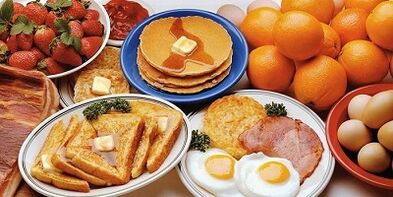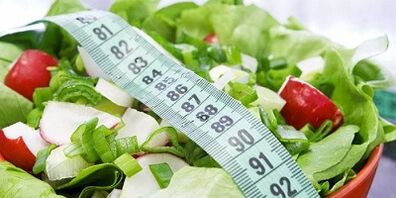Doctors, fitness trainers and nutritionists advise all questions about safe weight loss for the body to adhere to the principles of proper nutrition for weight loss.They recommend the same system for gaining weight and maintaining your figure, which helps you understand that a healthy diet is universal and with it you can achieve any bodybuilding goal.However, how can general rules be adjusted to a specific goal and should proper nutrition be perceived as a strict diet with a ban on any deviation to the left?
What does proper nutrition mean for weight loss?
Losing weight without compromising your health and the stress of hunger is what a healthy diet provides.Some people are intimidated by the need to count portion sizes and weigh food, but after several weeks of proper nutrition, a person learns to determine by eye what he can eat and how much.This system does not imply strict adherence to grams, so a minimal error will not cause weight stagnation.
The correct proportion of proteins, fats and carbohydrates

Every food product is made up of nutrients, and the base is made up of the 3 most important ones - proteins, fats and carbohydrates.They are abbreviated as BZHU.The proportion of these elements in the daily diet for body quality is no less important than the total amount of food per day.According to nutritionists, the issue of BJU balance should be put at the forefront, because if you violate these principles, you will not achieve fat burning when losing weight.
Proper nutrition for weight loss involves individually calculating the amount of each nutrient and several basic principles associated with this:
- CarbohydratesIt is an essential nutrient that provides the body with energy, which is why it should occupy half of the daily meal or a little more.When calculating individually, the amount of protein per day is 4 g for each kilogram of your weight.
- Fats– is also a very useful element, which is primarily a source of vitamins and acids that the nervous system and heart need.For the normal functioning of the body, it is necessary to consume 1.1 g of fat per kilogram of existing weight.
- Squirrels- the “building blocks” of your muscles.Some open sources advise focusing on them when losing weight, but the principles of proper nutrition to lose weight without harm to the body refute this recommendation.A person who does not do sports training does not need to ingest more than 1 g (per 1 kg of net weight).
Daily calorie intake
The amount of food a person can and should eat per day is determined by their basal metabolic rate.This indicator is calculated individually, taking into account the following indicators:
- gender;
- weight;
- growth;
- age.
However, the resulting number is not definitive if you decide to start losing or gaining weight.It also does not take into account physical activity – even walking from home to work, that is, it implies the amount of calories that a bedridden person needs for life.According to the principles of proper nutrition, it is necessary to further multiply this indicator by the level of activity, and then, if weight loss is planned, reduce the existing figure by 10-20%.
Principles of proper nutrition for weight loss
In addition to the dietary calorie and nutritional standards mentioned above, a healthy diet is based on a few more rules that you need to know and follow:
- Avoid fasting.
- Don't skip main meals.
- Breakfast and lunch are more satisfying than dinner.
- Give preference to fresh vegetables over thermally processed ones.
- Try not to use salt when cooking.
Weight loss products

Sweets are a must and buckwheat with lettuce is your best friend: this is how women imagine the daily diet of those who follow the principles of healthy eating.However, a healthy menu is much more varied, and recipes for healthy dishes may even look no worse than “harmful” ones and be comparable in appearance to restaurant ones.
The number of permitted foods is significantly greater than the prohibited list, and once you change your eating habits (mostly formed within 3 weeks), you will no longer feel deprived.
What can you eat to lose weight
The list of products that do not interfere with the reduction of fat reserves is long enough for you to create the right menu for the month, almost without repeating yourself.Mostly, dish ideas are limited by the variety in supermarkets or the skills of the housewife.
Experts call absolutely dietary products:
- Cereals are sources of slow carbohydrates and B vitamins. Especially recommended: oatmeal, buckwheat, corn, pearl barley.
- Legumes are light vegetable proteins.Chickpeas, lentils and beans are ideal for losing weight, but it's better not to rely on peas.
- Eggs - up to 2 per day, if with yolk, and up to 4, if only white.
- Vegetables contain fiber, that is, dietary fiber.Even potatoes are allowed, but the volume of their consumption is reduced.
- Fruits and dried fruits are an excellent substitute for factory sweets.
- Milk – minimum to prevent calcium deficiency, lactose-free.
- Fermented dairy products - with caution, in the evening yogurts will only be natural.
- Cottage cheese is preferably low-fat, but it is not necessary to look for low-fat.
- The cheese is mostly hard.
- Honey, nuts.
- Vegetable oil – preferably olive oil, up to 30 ml per day.
What to avoid when losing weight
The main enemies of the figure and factors that interfere with weight loss are saturated fats and fast carbohydrates.

The ideal is to eliminate them completely from the diet while losing weight, but an adequate diet is not a diet of lettuce leaves and chicken breast.
You are not prohibited from eating ice cream (simple carbohydrates, milk sugar), chocolate (simple carbohydrates) or even potato chips (saturated fat), but they must:
- meet daily calorie needs;
- be introduced into the menu rarely and not before bed.
Proper nutrition for weight loss involves an emphasis on healthy foods, so it is advisable to remove as much as possible from the diet:
- sausages and their “relatives” - sausages, bacon and so on;
- sugar (pay attention to the ingredients of the products);
- mayonnaise;
- sweet;
- cooking.
Diet Plan for Weight Loss
In addition to permitted and prohibited foods, there are several points that you should also consider when planning your daily diet:
- type of heat treatment;
- portion size;
- frequency of meals;
- drinking regime.
How to prepare healthy meals
The number of recipes for healthy dishes is a little smaller than conventional ones, so you don't have to worry about running out of cooking ideas.All methods of heat treatment are at your disposal, including frying, but it is done without oil, in a special non-stick frying pan.You can:
- to cook;
- to roast;
- cook in a water bath;
- stew;
- cook on the grill.
How many times a day to eat
The constant feeling of hunger is not something that promotes adequate eating to lose weight, even if it is necessary to lose weight urgently.If you follow the above principles of BJU balance, you will not starve, as carbohydrates will provide the desired degree of saturation.However, in addition to this, it is important to strictly follow the diet, which will help get rid of the urge to chew something every minute.

According to nutritionists, the correct diet is to eat up to 6 times a day.However, this value is determined individually:
- If you eat a portion of meat, saturation can last up to 4 hours, and the product will also take a long time to digest.
- If you have a snack with vegetables, after 2 hours the body needs to receive a new “dose” of food.
- According to the rules of healthy eating, it is advisable not to take long breaks (more than 4 hours) from the menu, so as not to cause a drop in sugar, which will lead to insulin spikes and a slowdown in metabolism.
Portion for Proper Nutrition for Weight Loss
Do you eat until you are full or do you feel hungry after eating?A question that torments most women who take off the scales before cooking.For some, weight loss inexorably involves reducing portions to ridiculous sizes, which causes collapse, as satiety does not occur.Doctors do not agree with this policy - even to lose weight, proper nutrition does not require fasting: the amount of food on the plate should be such that after half an hour you do not feel empty in your stomach, but also do not suffer from overeating.
Follow these guidelines:
- The amount of chicken or fish meat per serving is 100-150 g, visually it should not exceed the size of your palm.
- The volume of cereals and pasta is a handful in the palm of your hand, that is, 50 g or a little more.
- It is necessary to eat a lot of vegetables, so their portion is shelled (the food is cut into pieces).
- It is advisable to coordinate the correct portion size with the daily calorie content: do not exceed 400 kcal in the main meal and 200 kcal in the snack.
Compliance with the drinking regime
Some women and men underestimate the importance of water in the diet, especially when losing weight.Some people replace the concepts of “drink” and “tea” or “coffee”, but the drinking regime is pure still water, which does not actively burn fat, but is necessary for losing weight.Failure to comply with the correct drinking regime leads to lymph stagnation, thickening of the blood, dehydration, swelling, poor skin tone and deterioration of well-being.

Top recommendations on what and how to drink to lose weight properly:
- A glass of water before meals is a mandatory element on your menu.
- Each cup of coffee must be balanced with 0.6 liters of clean water, as... This drink causes dehydration.
- Juices, compotes and other drinks are foods;they don't count for the regime.
- Forget the 2-liter rule: the ideal amount of water is calculated individually.The norm for humans is 30 mg/kg.
Proper and balanced nutrition for weight loss - menu
To bring understanding to the method of creating a daily diet, we propose to follow a weight loss menu that does not cause hunger.This scheme can be expanded by adding 1-2 more snacks with vegetables/fruits, cheese, nuts.
Approximate daily nutritional program:
- Breakfast.Oatmeal or other porridge with water.A handful of almonds, a spoonful of honey.
- Snack.Wholemeal bread, hard cheese (up to 40 g), a lot of greens.
- To have lunch.Chicken broth with vegetables, a piece of boiled chicken.
- Afternoon snack.Canned red bean, pepper and cucumber salad.
- To have lunch.Roasted sole with asparagus and orange.























